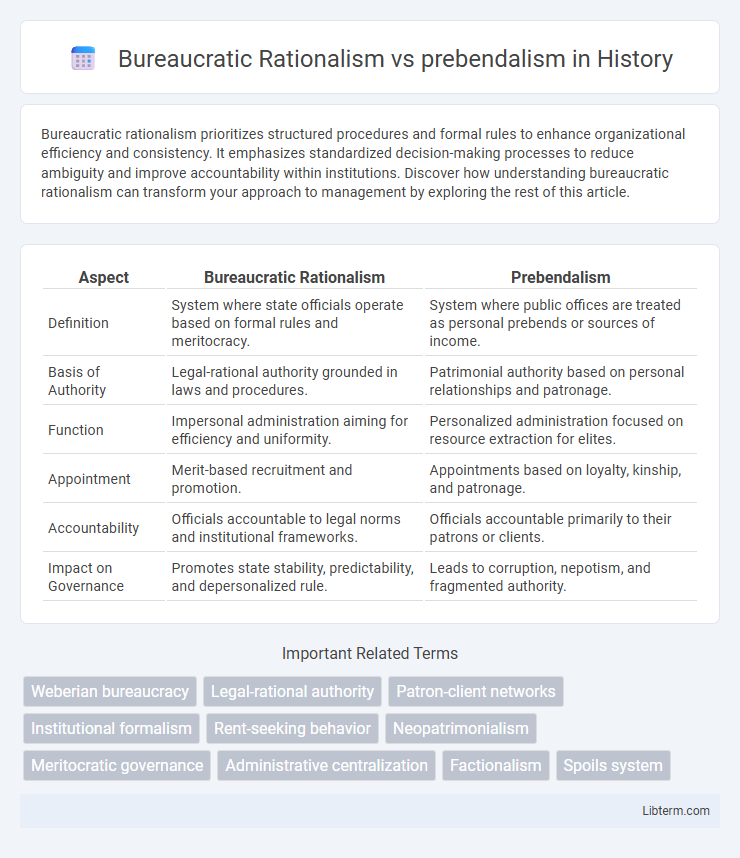Bureaucratic rationalism prioritizes structured procedures and formal rules to enhance organizational efficiency and consistency. It emphasizes standardized decision-making processes to reduce ambiguity and improve accountability within institutions. Discover how understanding bureaucratic rationalism can transform your approach to management by exploring the rest of this article.
Table of Comparison
| Aspect | Bureaucratic Rationalism | Prebendalism |
|---|---|---|
| Definition | System where state officials operate based on formal rules and meritocracy. | System where public offices are treated as personal prebends or sources of income. |
| Basis of Authority | Legal-rational authority grounded in laws and procedures. | Patrimonial authority based on personal relationships and patronage. |
| Function | Impersonal administration aiming for efficiency and uniformity. | Personalized administration focused on resource extraction for elites. |
| Appointment | Merit-based recruitment and promotion. | Appointments based on loyalty, kinship, and patronage. |
| Accountability | Officials accountable to legal norms and institutional frameworks. | Officials accountable primarily to their patrons or clients. |
| Impact on Governance | Promotes state stability, predictability, and depersonalized rule. | Leads to corruption, nepotism, and fragmented authority. |
Understanding Bureaucratic Rationalism: Core Principles
Bureaucratic rationalism emphasizes structured administration guided by formal rules, hierarchy, and merit-based decision-making to ensure efficiency and predictability in governance. It prioritizes objective criteria, standardized procedures, and professional expertise, contrasting sharply with prebendalism's reliance on patronage and personal loyalty. Core principles include rational-legal authority, impersonality, and adherence to codified regulations that foster accountability and transparency within public institutions.
Defining Prebendalism: Origins and Key Features
Prebendalism originates from the concept of public office as a personal resource for patronage, where officials treat state positions as prebends to dispense benefits to supporters. Key features include the allocation of state resources based on ethnicity, kinship, or political loyalty, leading to personalized governance and institutional corruption. This contrasts with bureaucratic rationalism, which emphasizes meritocratic principles, rule-based administration, and impersonal legal authority in public institutions.
Historical Contexts: Bureaucratic Rationalism vs Prebendalism
Bureaucratic rationalism emerged prominently during the 19th and 20th centuries as part of state-building efforts in Western Europe, emphasizing a merit-based, rule-governed administrative system designed to promote efficiency and impartiality. In contrast, prebendalism historically characterizes political systems, especially in post-colonial states like Nigeria, where public offices are treated as personal fiefdoms and resources are distributed based on ethnic or patron-client loyalties. The historical context of bureaucratic rationalism reflects classical modernization theories, while prebendalism arises from colonial legacies and socio-political fragmentation that challenge formal administrative norms.
Theoretical Frameworks: Weberian vs Clientelist Models
Bureaucratic rationalism, grounded in Max Weber's theoretical framework, emphasizes a formal, rule-based administration characterized by hierarchical authority, meritocracy, and impersonal relationships designed to enhance efficiency and predictability in governance. In contrast, prebendalism aligns with clientelist models where political actors treat public offices as personal fiefs, distributing resources based on patron-client networks rather than merit, undermining institutional norms and fueling corruption. These competing paradigms highlight the tension between ideal-type bureaucratic organization and pragmatic political resource allocation in governance studies.
Impacts on Governance and Public Administration
Bureaucratic rationalism enhances governance through structured, rule-based decision-making and efficient public administration, promoting transparency and accountability in policy implementation. In contrast, prebendalism undermines governance by encouraging patronage and the allocation of public resources for personal or group benefits, leading to corruption and weak institutional capacity. The tension between these models significantly affects administrative effectiveness, public trust, and overall state performance.
Institutional Structures: Hierarchies and Patronage
Bureaucratic rationalism emphasizes formal hierarchies with clear rules and merit-based advancement, ensuring efficient and predictable governance through standardized procedures. Prebendalism operates through patronage networks where institutional structures are informal, reliant on personal loyalty and the distribution of resources to maintain power. These contrasting frameworks shape how authority is exercised and resources are allocated within political and administrative systems.
Policy Outcomes: Efficiency vs Particularism
Bureaucratic rationalism promotes policy outcomes characterized by efficiency, impartial rule application, and merit-based resource allocation, enhancing overall institutional performance. In contrast, prebendalism fosters particularistic policy results driven by favoritism, personal interests, and patronage networks, often undermining effectiveness and accountability. The tension between these models significantly influences governance quality and development trajectories in public administration.
Corruption and Accountability in Both Systems
Bureaucratic rationalism emphasizes standardized procedures and merit-based administration, reducing corruption by enforcing accountability through formal institutions and clear rules. In contrast, prebendalism fosters corruption by allowing public officials to treat state resources as personal property, prioritizing patronage and loyalty over merit and formal accountability. The variation in accountability mechanisms creates significant differences in corruption levels, with bureaucratic rationalism promoting transparency, while prebendalism undermines institutional integrity.
Case Studies: Global Examples of Bureaucratic Rationalism and Prebendalism
Bureaucratic rationalism is exemplified by Singapore's efficient civil service, which emphasizes meritocracy, rule-based governance, and institutional transparency, fostering economic growth and political stability. In contrast, Nigeria illustrates prebendalism, where political offices are treated as personal fiefdoms, leading to patronage, corruption, and fragmented governance. Comparative studies reveal that bureaucratic rationalism promotes sustainable development through depersonalized administration, whereas prebendalism undermines state capacity by entrenching clientelism and parochial interests.
Reform Strategies: Toward Transparent and Rational Governance
Reform strategies addressing bureaucratic rationalism versus prebendalism emphasize strengthening institutional frameworks with transparent procedures and merit-based appointments to curb patronage and corruption. Implementing e-governance and performance audits enhances accountability, reducing discretionary power vulnerable to prebendal influences. Encouraging civic participation and legal reforms fosters a culture of rational decision-making aligned with public interest and administrative efficiency.
Bureaucratic Rationalism Infographic

 libterm.com
libterm.com